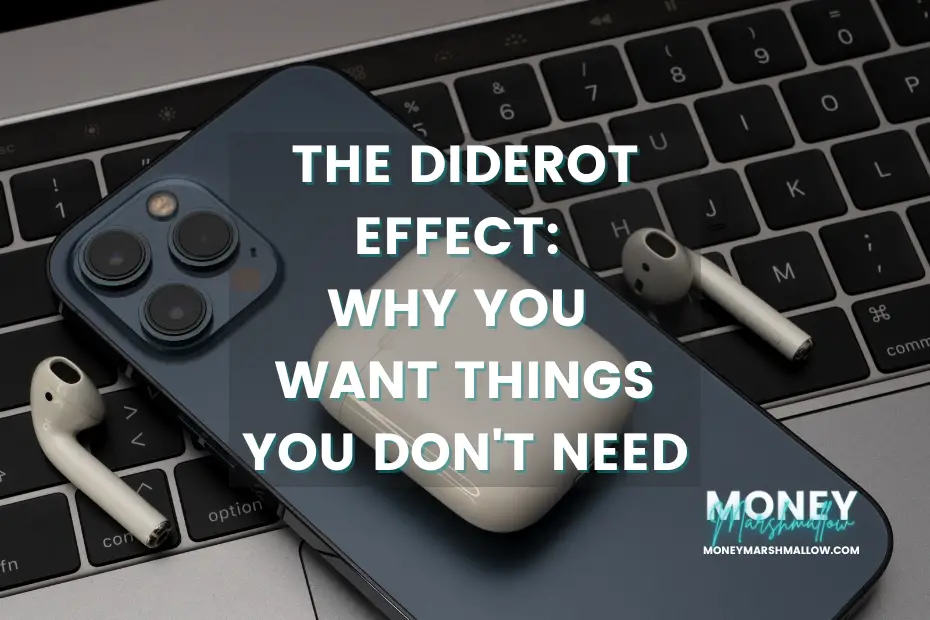In a world consumed by the pursuit of possessions and the never-ending quest for more, we often find ourselves trapped in a cycle of discontentment. Inspired by the story of Denis Diderot and his fateful scarlet robe, we delve into the fascinating phenomenon known as the Diderot Effect—a relentless spiral of consumption that leaves us perpetually wanting.
This article reveals the strategies to conquer the Diderot Effect and reclaim true contentment. Join us as we explore practical techniques, delve into the psychology of desire, and embrace a simpler, intentional way of living.
What is the Diderot effect?
Picture this: a famous philosopher, Denis Diderot, spent most of his life struggling with poverty. But in 1765, everything changed. Diderot faced the daunting task of providing a dowry for his daughter’s wedding, an expense he couldn’t afford. Little did he know, a generous offer from Catherine the Great, the Empress of Russia, would not only solve his financial troubles but also give birth to an intriguing phenomenon known as the Diderot Effect.
So, what exactly is the Diderot Effect? Let’s delve into the story behind it. It all began when Diderot acquired a stunning scarlet robe, a symbol of newfound prosperity. But there was a hitch – the robe clashed with his humble belongings, creating a jarring contrast. Suddenly, a burning desire to transform his surroundings was ignited within him.
Motivated by this mismatch, Diderot went on a determined mission to make everything match. The scarlet robe became the trigger that set off a chain reaction of consumption. He traded the rug, brought in sculptures, upgraded the kitchen table, and even exchanged his humble straw chair for a fancy leather one. Each purchase aimed to restore harmony, but instead, it fueled an ongoing cycle of acquiring more and more.
These reactive purchases have come to be recognised as the Diderot Effect. According to the Diderot Effect, acquiring a new item often sets off a chain reaction of consumption, compelling us to accumulate even more. Consequently, we find ourselves buying things that our former selves never required to experience happiness or contentment.

Why you want things you don't need
The Diderot Effect sheds light on our inclination to desire new possessions, even when they are unnecessary. It is a phenomenon that many of us can relate to, as we find ourselves caught in a cycle of consumption driven by the pursuit of harmony and enhancement. Here are some examples of the Diderot Effect in various aspects of our life:
Tech: When you purchase a new smartphone or computer, you might feel the need to upgrade your accessories, such as cases, screen protectors, chargers, and headphones, to match the new device.
Fashion: Upgrading your wardrobe with a few new clothing items can trigger a desire for additional accessories, such as shoes, belts, jewelry, and handbags, to complete your desired look. The desire for a cohesive personal style can lead to a cycle of acquiring more items.
Home Decor: Changing the decor of one room in your house, such as redecorating the bedroom, may inspire you to reconsider the design of other rooms. This can result in a domino effect of purchasing new furniture, artwork, lighting fixtures, and decorative items to create a cohesive aesthetic throughout your home.
In our quest for contentment and satisfaction, we often find ourselves seeking more, rather than embracing simplicity. The Diderot Effect reveals our natural inclination to accumulate, add, upgrade, and build upon our possessions. By recognising this tendency and adopting a mindset of mindful consumption, we can break free from the cycle of unnecessary acquisition and find fulfilment in simplicity and contentment.
How brands use the Diderot Effect to make you buy more
The Diderot Effect is not just a psychological phenomenon; it’s also a powerful marketing tool that brands often leverage to encourage you to spend more in stores. Companies like Ikea and Apple have successfully employed strategies to make customers buy more than they originally intended.
Ikea entices customers to make additional purchases with their well-known, carefully crafted showrooms. Ikea triggers the Diderot Effect by presenting complete room setups, prompting shoppers to buy more than they originally intended. For instance, when customers encounter a tastefully arranged living room with a couch, coffee table, and shelves, they feel compelled to acquire complementary items such as cushions, curtains, and rugs that enhance the showcased arrangement.
Meanwhile, Apple has mastered the art of the Diderot Effect by creating a seamless ecosystem of products and accessories. When customers purchase an Apple device like an iPhone or MacBook, they are introduced to a range of compatible accessories and services such as AirPods, Apple Watch, and iCloud. The sleek design and interconnectivity of these products make customers feel the need to complete their Apple collection, driving them to buy more items that enhance their overall Apple experience.
The Diderot Effect is also a common e-commerce trick to encourage additional purchases. Product recommendations are one example of this; online stores often display personalised recommendations based on your browsing and purchase history. By suggesting complementary items or products frequently bought together, they stimulate the desire to complete a set or enhance the functionality of a particular item.
By strategically implementing these techniques, brands capitalise on the Diderot Effect, enticing customers to make additional purchases. Be aware of these tactics and approach your buying decisions with a critical eye to avoid falling into the trap of unnecessary spending.

How to overcome the Diderot Effect
Breaking free from the Diderot Effect requires a conscious effort and a shift in mindset. By adopting a few key strategies, we can regain control over our consumption patterns and find contentment in what we already possess.
1. Limit exposure to triggers
Minimise your exposure to triggers that initiate the Diderot Effect. Unsubscribe from commercial emails and avoid unnecessarily visiting shopping websites or stores. If social media triggers your impulse purchases, unfollow brands and influencers that constantly promote consumerism. You can minimise exposure to tempting advertisements and impulse-inducing content by curating your online feed.
2. Buy items that fit your current posessions
Seek out purchases that complement your existing belongings. Consider how new items will fit into your lifestyle and avoid the need for additional accessories or upgrades. This approach prevents the spiral of consumption and encourages mindful buying.
3. Embrace a no-spend month
Challenge yourself to abstain from buying non-essential items for an entire month. Instead, focus on using what you already have, borrowing from friends or family, or exploring secondhand options. A no-spend challenge encourages resourcefulness, breaks the cycle of constant acquisition, and helps you evaluate your true needs versus wants.
4. Practice mindful consumption
Adopt a mindful approach to your purchases. Before buying something new, pause and ask yourself if it aligns with your values and brings genuine value to your life. Consider the long-term implications and the potential clutter it may create. This reflection can help you make more intentional and conscious decisions.
5. Cultivate gratitude
Shift your focus from constantly wanting more to appreciating what you already have. Practice gratitude for the belongings that serve you well and bring joy to your life. By nurturing contentment, you can resist the urge to chase unnecessary possessions and find fulfillment in the present moment.
Conclusion
The Diderot Effect sheds light on our inherent tendency to accumulate possessions, driving our desire for unnecessary items. Named after the French philosopher Denis Diderot, who experienced this firsthand, it refers to the spiral of consumption that occurs when we buy new things, leading us to purchase more in pursuit of coherence and harmony.
Recognising the power of the Diderot Effect and how brands exploit it is vital. To overcome its influence, we can reduce exposure to triggers, practice more mindful spending, and embrace a simpler lifestyle. By embracing simplicity and finding contentment in what we already have, we regain control over our desires and cultivate a sense of fulfillment that transcends the relentless pursuit of material possessions.

